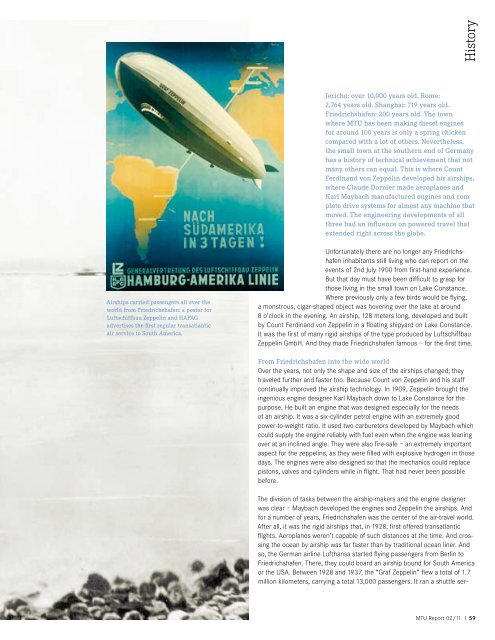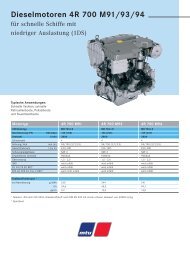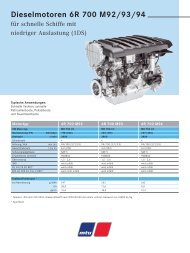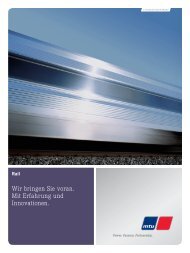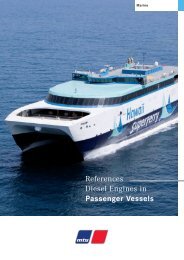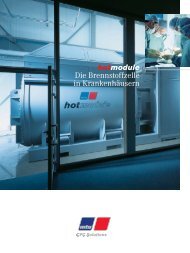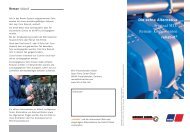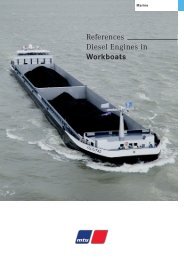Create successful ePaper yourself
Turn your PDF publications into a flip-book with our unique Google optimized e-Paper software.
Airships carried passengers all over the<br />
world from Friedrichshafen: a poster for<br />
Luftschiffbau Zeppelin and HAPAG<br />
advertises the first regular transatlantic<br />
air service to South America.<br />
History<br />
Jericho: over 10,000 years old. Rome:<br />
2,764 years old. Shanghai: 719 years old.<br />
Friedrichshafen: 200 years old. The town<br />
where <strong>MTU</strong> has been making diesel engines<br />
for around 100 years is only a spring chicken<br />
compared with a lot <strong>of</strong> others. Nevertheless,<br />
the small town at the southern end <strong>of</strong> Germany<br />
has a history <strong>of</strong> technical achievement that not<br />
many others can equal. This is where Count<br />
Ferdinand von Zeppelin developed his air ships,<br />
where Claude Dornier made aeroplanes and<br />
Karl Maybach manufactured engines and complete<br />
drive systems for almost any machine that<br />
moved. The engineering developments <strong>of</strong> all<br />
three had an influence on powered travel that<br />
extended right across the globe.<br />
Unfortunately there are no longer any Friedrichshafen<br />
inhabitants still living who can report on the<br />
events <strong>of</strong> 2nd July 1900 from first-hand experience.<br />
But that day must have been difficult to grasp for<br />
those living in the small town on Lake Constance.<br />
Where previously only a few birds would be flying,<br />
a monstrous, cigar-shaped object was hovering over the lake at around<br />
8 o’clock in the evening. An airship, 128 meters long, developed and built<br />
by Count Ferdinand von Zeppelin in a floating shipyard on Lake Constance.<br />
It was the first <strong>of</strong> many rigid airships <strong>of</strong> the type produced by Luftschiffbau<br />
Zeppelin GmbH. And they made Friedrichshafen famous – for the first time.<br />
From Friedrichshafen into the wide world<br />
Over the years, not only the shape and size <strong>of</strong> the airships changed; they<br />
traveled further and faster too. Because Count von Zeppelin and his staff<br />
continually improved the airship technology. In 1909, Zeppelin brought the<br />
ingenious engine designer Karl Maybach down to Lake Constance for the<br />
purpose. He built an engine that was designed especially for the needs<br />
<strong>of</strong> an airship. It was a six-cylinder petrol engine with an extremely good<br />
power-to-weight ratio. It used two carburetors developed by Maybach which<br />
could supply the engine reliably with fuel even when the engine was leaning<br />
over at an inclined angle. They were also fire-safe – an extremely important<br />
aspect for the zeppelins, as they were filled with explosive hydrogen in those<br />
days. The engines were also designed so that the mechanics could replace<br />
pistons, valves and cylinders while in flight. That had never been possible<br />
before.<br />
The division <strong>of</strong> tasks between the airship-makers and the engine designer<br />
was clear – Maybach developed the engines and Zeppelin the airships. And<br />
for a number <strong>of</strong> years, Friedrichshafen was the center <strong>of</strong> the air-travel world.<br />
After all, it was the rigid airships that, in 1928, first <strong>of</strong>fered transatlantic<br />
flights. Aeroplanes weren’t capable <strong>of</strong> such distances at the time. And crossing<br />
the ocean by airship was far faster than by traditional ocean liner. And<br />
so, the German airline Lufthansa started flying passengers from Berlin to<br />
Friedrichshafen. There, they could board an airship bound for South America<br />
or the USA. Between 1928 and 1937, the “Graf Zeppelin” flew a total <strong>of</strong> 1.7<br />
million kilometers, carrying a total 13,000 passengers. It ran a shuttle ser-<br />
<strong>MTU</strong> Report 02/11 I 59


